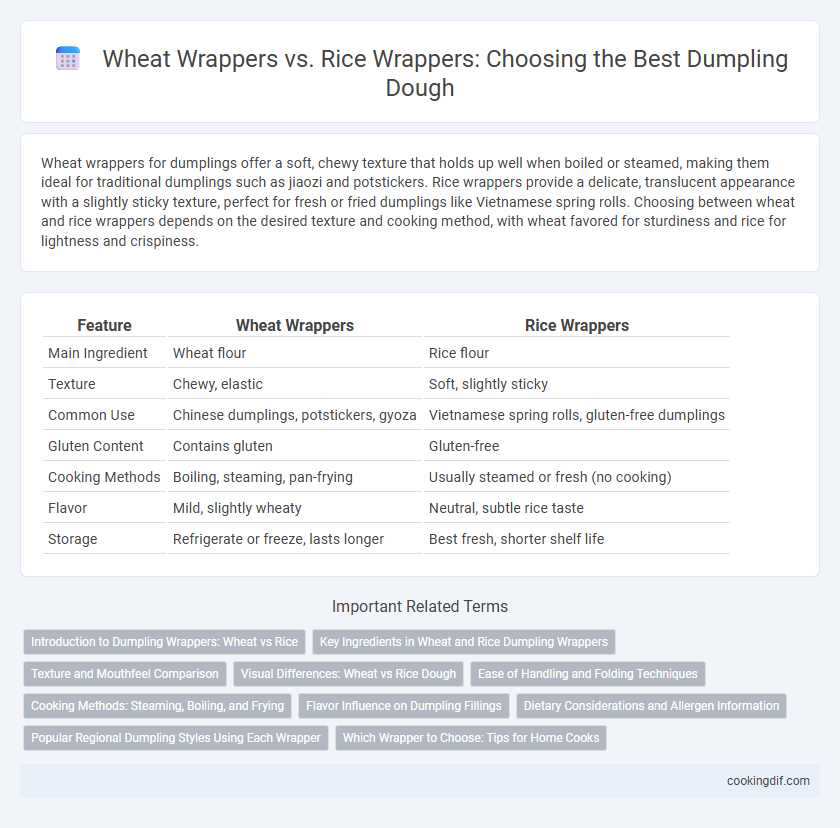Wheat wrappers for dumplings offer a soft, chewy texture that holds up well when boiled or steamed, making them ideal for traditional dumplings such as jiaozi and potstickers. Rice wrappers provide a delicate, translucent appearance with a slightly sticky texture, perfect for fresh or fried dumplings like Vietnamese spring rolls. Choosing between wheat and rice wrappers depends on the desired texture and cooking method, with wheat favored for sturdiness and rice for lightness and crispiness.
Table of Comparison
| Feature | Wheat Wrappers | Rice Wrappers |
|---|---|---|
| Main Ingredient | Wheat flour | Rice flour |
| Texture | Chewy, elastic | Soft, slightly sticky |
| Common Use | Chinese dumplings, potstickers, gyoza | Vietnamese spring rolls, gluten-free dumplings |
| Gluten Content | Contains gluten | Gluten-free |
| Cooking Methods | Boiling, steaming, pan-frying | Usually steamed or fresh (no cooking) |
| Flavor | Mild, slightly wheaty | Neutral, subtle rice taste |
| Storage | Refrigerate or freeze, lasts longer | Best fresh, shorter shelf life |
Introduction to Dumpling Wrappers: Wheat vs Rice
Dumpling wrappers play a crucial role in texture and flavor, with wheat wrappers offering a chewy, elastic bite ideal for boiled or pan-fried dumplings, while rice wrappers provide a delicate, translucent appearance and a soft, slightly sticky texture perfect for steamed varieties like Vietnamese spring rolls. Wheat wrappers are made from wheat flour and water, sometimes with added salt, creating a sturdy dough that holds fillings well and browns nicely when cooked. Rice wrappers, crafted from rice flour and water, are thinner and more fragile, requiring careful handling but delivering a subtle flavor that complements light, fresh ingredients.
Key Ingredients in Wheat and Rice Dumpling Wrappers
Wheat dumpling wrappers primarily consist of high-protein wheat flour, water, and sometimes salt, which create a chewy and elastic texture ideal for holding robust fillings. Rice dumpling wrappers use rice flour or glutinous rice flour mixed with water, resulting in a translucent, delicate, and slightly sticky skin that pairs well with lighter or steamed dumplings. The protein content in wheat flour contributes to gluten development, while rice flour's starch properties provide a tender bite without elasticity.
Texture and Mouthfeel Comparison
Wheat wrappers offer a chewy and elastic texture that holds fillings firmly, creating a satisfying bite with a slightly dense mouthfeel. Rice wrappers provide a delicate, translucent skin with a softer, silkier texture that melts quickly on the palate, enhancing the subtlety of fillings. The choice between wheat and rice wrappers significantly influences the overall sensory experience, with wheat delivering robustness and rice emphasizing tenderness.
Visual Differences: Wheat vs Rice Dough
Wheat wrappers for dumplings have a smooth, elastic texture with a slightly translucent, off-white appearance, allowing for a flexible fold that holds fillings securely. Rice wrappers are typically thinner, more translucent, and have a shinier, almost glossy surface, often slightly more brittle and opaque when dried. The stark visual contrast between the off-white matte wheat dough and the glossy, delicate rice dough helps distinguish these wrappers in dumpling presentation.
Ease of Handling and Folding Techniques
Wheat wrappers offer greater elasticity and strength, making them easier to handle and fold without tearing during dumpling preparation. Rice wrappers, known for their delicate and brittle texture, require gentle manipulation and quicker folding techniques to prevent breakage. Mastering folding techniques with wheat wrappers enhances consistency, while rice wrappers demand precision and care for optimal results.
Cooking Methods: Steaming, Boiling, and Frying
Wheat wrappers offer a pliable texture that crisps well when fried and holds up firmly during boiling, making them ideal for pan-frying and boiling dumplings without tearing. Rice wrappers, often translucent and delicate, excel in steaming methods, producing a smooth, tender dumpling skin that retains moisture but may become soggy if boiled or fried. Each wrapper type influences the cooking outcome: wheat delivers a hearty, chewy bite suitable for frying and boiling, while rice provides a soft, delicate texture best showcased through steaming.
Flavor Influence on Dumpling Fillings
Wheat wrappers provide a chewy texture and a neutral flavor that complements savory dumpling fillings like pork or beef, enhancing the meat's richness without overpowering the taste. Rice wrappers, made from rice flour, offer a lighter, slightly sweet flavor that pairs well with delicate or seafood fillings, allowing subtler ingredients such as shrimp or vegetables to shine. The choice between wheat and rice wrappers significantly influences the overall flavor profile and mouthfeel of the dumpling, making it essential to match the wrapper type with the filling for optimal taste harmony.
Dietary Considerations and Allergen Information
Wheat wrappers for dumplings contain gluten, making them unsuitable for individuals with celiac disease or gluten intolerance, while rice wrappers are naturally gluten-free and a safer choice for those with such dietary restrictions. Rice wrappers tend to be lower in calories and carbohydrates compared to wheat wrappers, appealing to those following gluten-free or low-carb diets. Both options offer distinct textures and allergen profiles, with rice wrappers catering to people avoiding wheat allergens.
Popular Regional Dumpling Styles Using Each Wrapper
Wheat wrappers dominate Northern Chinese dumplings such as jiaozi, prized for their chewy texture and ability to hold substantial fillings. Rice wrappers, often used in Southern Chinese dishes like har gow and Vietnamese banh cuon, provide a delicate, translucent finish that complements lighter, seafood-based fillings. Each wrapper reflects regional culinary traditions, with wheat appearing in heartier, pan-fried or boiled dumplings, while rice wrappers prevail in steamed, silky varieties.
Which Wrapper to Choose: Tips for Home Cooks
Wheat wrappers offer a chewy texture and are ideal for pan-fried or steamed dumplings, providing durability that holds fillings well during cooking. Rice wrappers, softer and more translucent, suit fresh or steamed dumplings like Vietnamese spring rolls but can be delicate to handle. For home cooks, choosing wheat wrappers ensures ease of use and versatility, while rice wrappers are perfect for lighter, gluten-free options requiring gentle cooking methods.
Wheat wrappers vs Rice wrappers for dumpling dough Infographic

 cookingdif.com
cookingdif.com